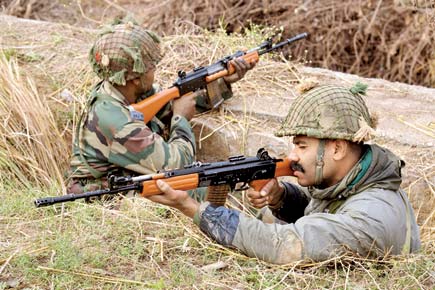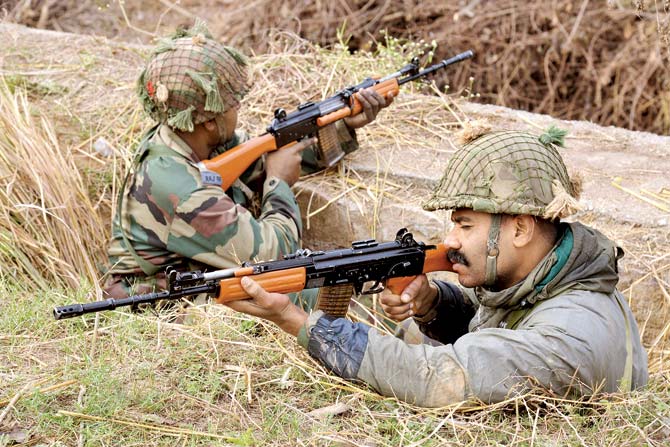Only sustained Indo-Pak peace efforts can neutralise the threat of such terror attacks in the long run

 The Pathankot attack has brought out a lot of shortcomings in our system, from the quality of our border management to that of local policing and counter-terrorism response. One aspect has been the indication that the whole response is being directed from the very top by NSA Ajit Doval. If so, this is wrong, and Doval must not confuse his role as a strategic leader of India’s national security system with that of a tactician.
The Pathankot attack has brought out a lot of shortcomings in our system, from the quality of our border management to that of local policing and counter-terrorism response. One aspect has been the indication that the whole response is being directed from the very top by NSA Ajit Doval. If so, this is wrong, and Doval must not confuse his role as a strategic leader of India’s national security system with that of a tactician.

Indian soldiers take position on the perimeter of the Pathankot airforce base. This is the fifth attack since September 2013, following a near identical pattern. Pic/AFP
As the supervisor of the intelligence agencies, he runs the loop and must, of course, keep the PM in it. But when it comes to actual ground action, he should leave it to pre-designated people along assigned lines of authority. The problem is, as the Pathankot events have revealed, there does not seem to be a clearly laid out line of command to deal with such events.
In the past two days, we have seen the base commander Air Commodore JS Dhamoon and NSG Major-General Dushyant Singh, brief the press in Pathankot, while in New Delhi, Home Secretary Rajiv Mehrishi and Air Marshal Anil Khosla (Director General Air Operations at Air Headquarters) spoke to the media. Earlier, we were told that the Air Officer Commanding in Chief of the Western Air Command, Air Marshal S B Deo, had reached Pathankot on the evening of January 1, several hours before the attack. So who was in charge?
With the Pathankot attack having dragged on for the third day, we need to ask questions about our counter-terrorist strategy and tactics. First, the strategic aspect: The attack was not entirely unexpected. Every time efforts are made for normalisation, there is a push-back by forces opposed to it. The question is whether Prime Minister Narendra Modi’s surprise visit to Lahore was carefully thought through? Was there any effort to assess the mood of the Pakistan Army? Because you can be sure that the attack was ordered by the Inter Services Intelligence (ISI) Directorate of the Pakistan Army, which does not seem to be particularly happy about the Nawaz-Modi meeting.
Then there is the question of the Indian response. This is the fifth attack since September 2013, following a near identical pattern. A small group of militants in army fatigues cross the international border in Jammu & Kashmir, which runs roughly parallel to the National Highway 1A in a south-easterly direction from Jammu to Kathua, and then loops south at the Ravi river to Pathankot and Gurdaspur. After crossing the border they make their way to the highway, hijack a passing vehicle and attack their target, usually a police station or an army camp.
In the case of the Pathankot attack — from available reports — it seems the attackers crossed the international border and audaciously hired a taxi around 8 pm on December 31. When it had an accident, they hijacked the car of the SP of Gurdaspur, Salwinder Singh, near Dinanagar, and used it to reach the Pathankot air base. They hid out through the entire day of January 1 and launched the attack in the early hours of January 2.
Remarkably, by the evening of January 1, the authorities knew that an attack was imminent and the government had dispatched an NSG unit under Major-General Singh to Pathankot, along with the Western Air Command chief. Reportedly, two companies of the Army were also sent to the base.
Officials initially said that four attackers and seven security personnel had been killed by midday January 3. But subsequently, they said that some of the attackers may still be around and operations continued through till Monday, when the remaining militants were killed some time around noon.
There are many questions about the manner in which the attack was handled. Why, despite the SP and his driver alerting the Punjab Police, was nothing done by way of search and arrest operations through Friday? The Mehrishi press conference indicates that the NSG was only deployed after the attack was launched in the early hours of Saturday. Dhamoon acknowledged that the attackers had managed to reach the mess of the base, where unsuspecting jawans — possibly unarmed — were killed while readying for breakfast.
The biggest question really relates to the ability of the Pakistani teams to penetrate the border, which is supposed to be fenced, floodlit and surveilled with TV cameras and heavily patrolled by the BSF. True, the terrain is riverine and heavily serrated, but successive attacks should have led the authorities to raise their level of surveillance capabilities, perhaps adding thermal imagers, motion sensors and the like to their arsenal. In the history of recent and troubled relations between India and Pakistan, such terrorist attacks take place whenever there are efforts to improve relations. It would be downright foolish to play into the hands of these people and stop the process of normalisation. Sustained engagement is the only way to neutralise them.
But knowing that such attacks will occur whenever we try to improve relations with Pakistan, it becomes all the more important to anticipate them and be prepared.
The writer is a Distinguished Fellow, Observer Research Foundation, New Delhi
 Subscribe today by clicking the link and stay updated with the latest news!" Click here!
Subscribe today by clicking the link and stay updated with the latest news!" Click here!









